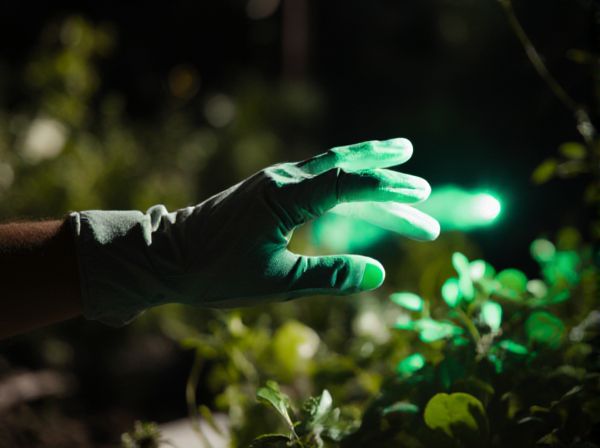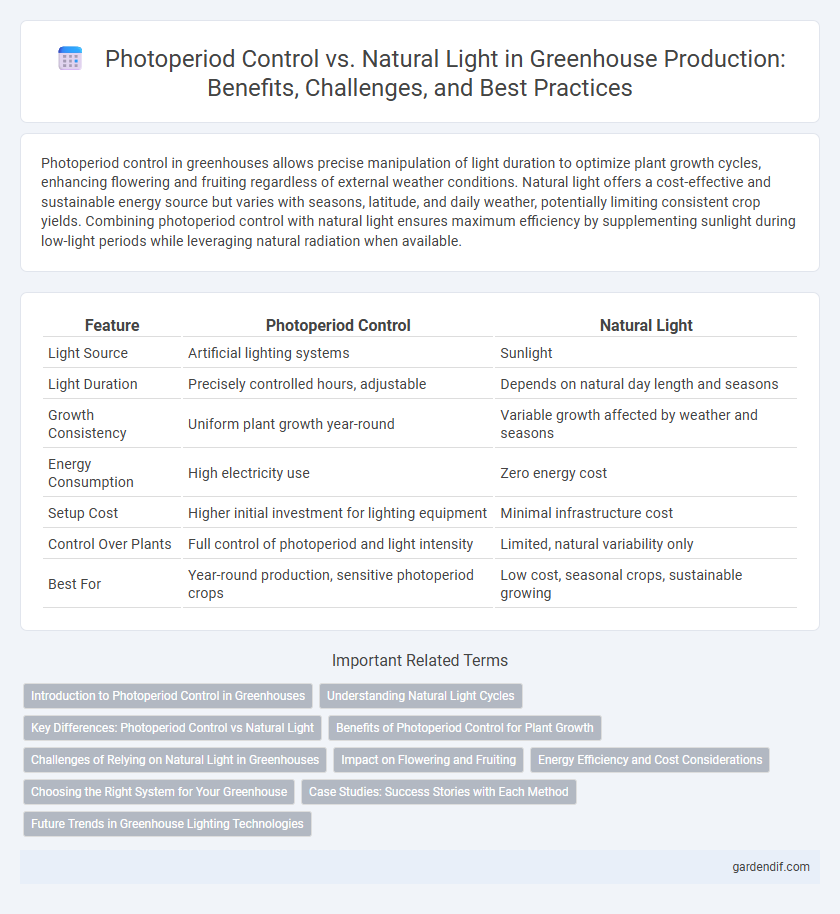
Photoperiod Control vs Natural Light Illustration
Photoperiod control in greenhouses allows precise manipulation of light duration to optimize plant growth cycles, enhancing flowering and fruiting regardless of external weather conditions. Natural light offers a cost-effective and sustainable energy source but varies with seasons, latitude, and daily weather, potentially limiting consistent crop yields. Combining photoperiod control with natural light ensures maximum efficiency by supplementing sunlight during low-light periods while leveraging natural radiation when available.
Table of Comparison
| Feature | Photoperiod Control | Natural Light |
|---|---|---|
| Light Source | Artificial lighting systems | Sunlight |
| Light Duration | Precisely controlled hours, adjustable | Depends on natural day length and seasons |
| Growth Consistency | Uniform plant growth year-round | Variable growth affected by weather and seasons |
| Energy Consumption | High electricity use | Zero energy cost |
| Setup Cost | Higher initial investment for lighting equipment | Minimal infrastructure cost |
| Control Over Plants | Full control of photoperiod and light intensity | Limited, natural variability only |
| Best For | Year-round production, sensitive photoperiod crops | Low cost, seasonal crops, sustainable growing |
Introduction to Photoperiod Control in Greenhouses
Photoperiod control in greenhouses involves regulating light exposure to mimic natural daylengths or create specific light cycles that optimize plant growth and flowering. This technique uses artificial lighting systems, such as LED or high-intensity discharge lamps, to extend or shorten photoperiods, enhancing crop yield and quality. Compared to relying solely on natural light, photoperiod control provides precise environmental management that supports year-round production and improved horticultural outcomes.
Understanding Natural Light Cycles
Natural light cycles provide plants in greenhouses with fluctuating periods of sunlight and darkness essential for photoperiodic regulation and growth. Understanding the intensity, duration, and spectral quality of natural sunlight enables growers to optimize crop development and flowering schedules. Precise monitoring of natural light variations supports the integration of supplemental lighting to maintain consistent photoperiod control in controlled environments.
Key Differences: Photoperiod Control vs Natural Light
Photoperiod control in greenhouses uses artificial lighting to regulate plant growth cycles by extending or shortening daylight hours, whereas natural light depends on the sun's daily and seasonal variations. Photoperiod control enables precise manipulation of flowering and vegetative phases, improving crop yields and quality regardless of external weather conditions. Natural light varies with climate and location, making it less predictable but energy-efficient and essential for certain plant species requiring consistent solar spectra.
Benefits of Photoperiod Control for Plant Growth
Photoperiod control in greenhouses allows precise regulation of light exposure, optimizing photosynthesis and flowering cycles regardless of external daylight variations. This method enhances crop yield consistency, accelerates growth rates, and supports year-round production by simulating ideal light conditions. Controlled photoperiods also reduce the risk of light stress and improve energy efficiency compared to reliance on natural light alone.
Challenges of Relying on Natural Light in Greenhouses
Relying on natural light in greenhouses presents challenges such as inconsistent light intensity and duration due to weather variability and seasonal changes, which can impede optimal plant growth and yield. Variations in sunlight can cause uneven photosynthesis, affecting crop uniformity and quality. Greenhouse operators often face difficulties in maintaining ideal photoperiods necessary for specific plant developmental stages without supplementary lighting systems.
Impact on Flowering and Fruiting
Photoperiod control in greenhouses enables precise regulation of light exposure, significantly enhancing flowering and fruiting cycles by simulating optimal day-length conditions for specific plant species. In contrast, reliance on natural light subjects plants to seasonal and weather-related variability, potentially delaying or reducing flowering and fruit yield. Controlled photoperiod systems improve crop uniformity, increase production efficiency, and enable year-round cultivation regardless of external environmental changes.
Energy Efficiency and Cost Considerations
Photoperiod control systems in greenhouses use artificial lighting to extend or shorten daylight hours, allowing precise regulation of plant growth cycles while increasing energy consumption compared to relying solely on natural light. Although natural light reduces electricity costs and minimizes environmental impact, it limits control over photoperiodicity and may result in inconsistent crop yields. Balancing energy efficiency with crop productivity requires evaluating the cost of supplemental lighting against potential increases in revenue from optimized growth conditions.
Choosing the Right System for Your Greenhouse
Photoperiod control systems provide precise regulation of light duration, enabling year-round crop consistency and optimized flowering cycles, unlike natural light which varies with seasons and weather conditions. Selecting the right system depends on crop type, growth stage, and energy budget; high-value crops like tomatoes or orchids benefit from photoperiod control to maximize yield and quality. Integrating supplemental lighting with natural light can improve photosynthesis efficiency while minimizing energy costs in greenhouse operations.
Case Studies: Success Stories with Each Method
Case studies highlight that photoperiod control in greenhouses consistently boosts crop yields by extending daylight hours, especially for short-day plants like chrysanthemums, resulting in up to 30% faster growth cycles. Conversely, natural light reliance in glasshouse systems has proven effective for high-value crops such as tomatoes, where optimized environmental control systems maintain steady production with lower energy costs. Success with each method depends on crop type, energy resources, and climate conditions, demonstrating tailored approaches maximize horticultural productivity.
Future Trends in Greenhouse Lighting Technologies
Emerging greenhouse lighting technologies emphasize precise photoperiod control to optimize plant growth cycles, surpassing the limitations of natural light variability. Advanced LED systems with customizable spectra support year-round cultivation, enhancing photosynthesis efficiency and crop yield. Integration of AI-driven light management enables dynamic adjustments to photoperiods, fostering sustainable and energy-efficient greenhouse operations.
Photoperiod Control vs Natural Light Infographic

 gardendif.com
gardendif.com